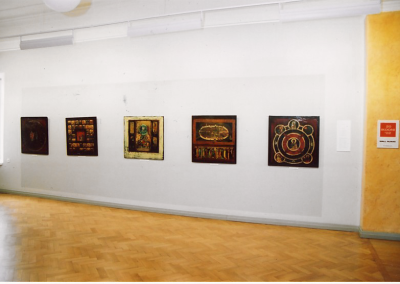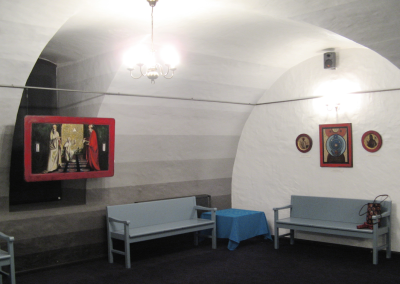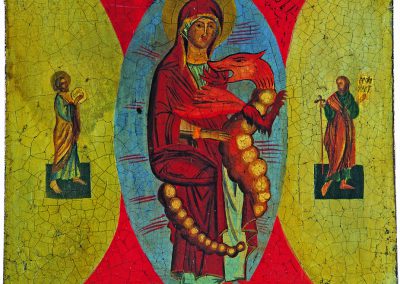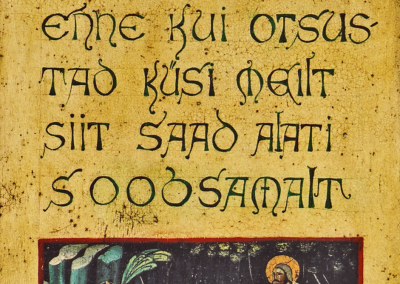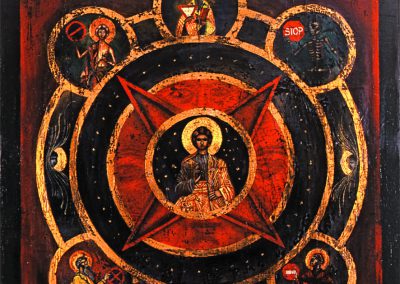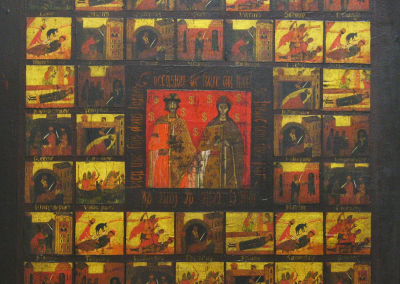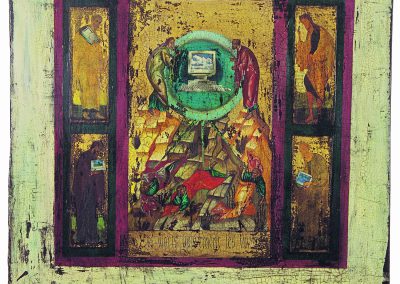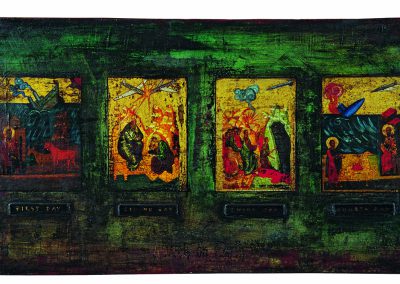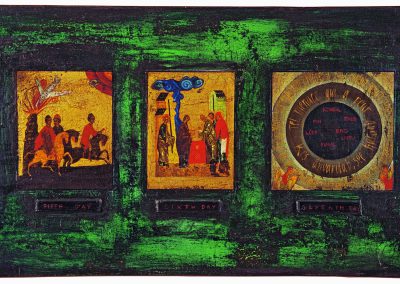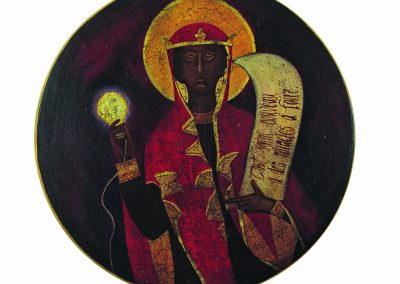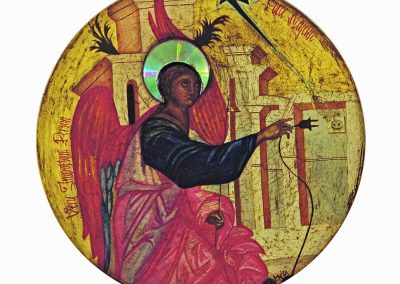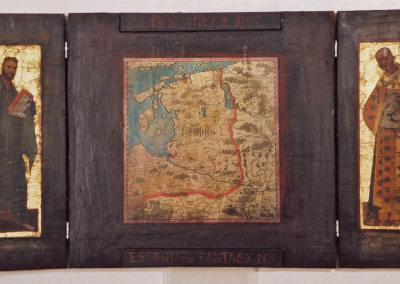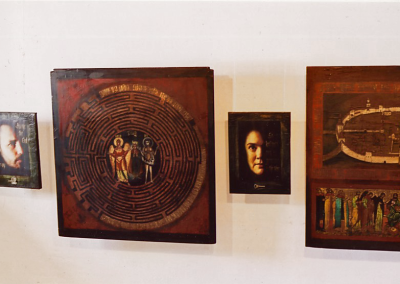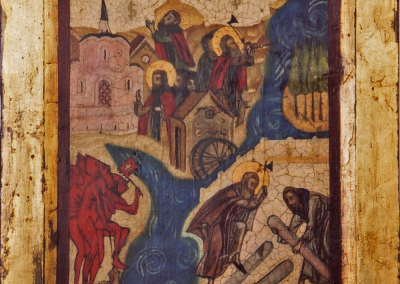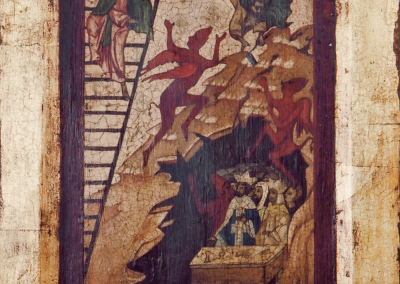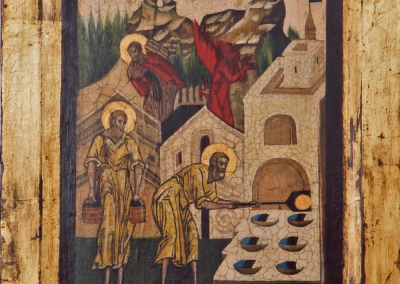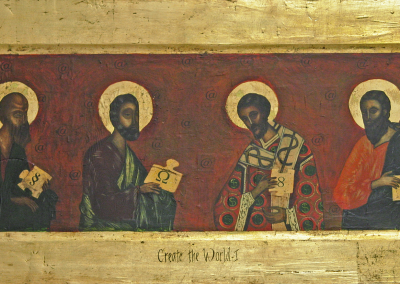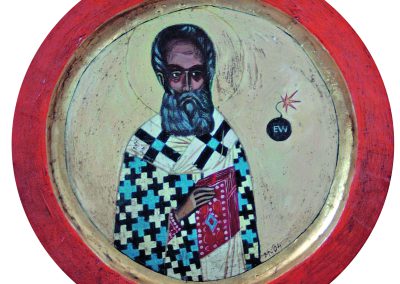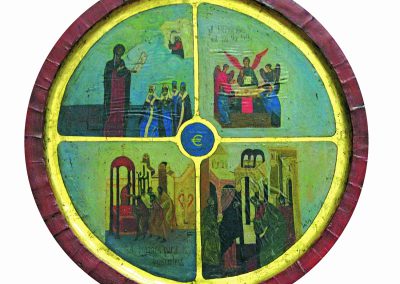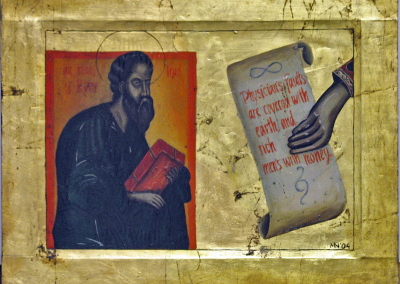„Icons“
2000–2004
Icons 2000–2004
About three years ago a change took place in Nukke’s work. Once again she is the DJ in human history sampling together different periods, meanings and images. In her work we continue to see subtle irony, a faint smile and the Heimlich manoeuvre (a technique of ejecting an obstruction from the throat of a choking victim) performed on history as well as great celebrities. Firstly, the change in Nukke’s work is naturally formal. She has started to make use of the structure, composition, painting method and details characteristic of old Russian icons. Experimenting in a variety of ways she has even applied her “pop-icons” with a cracked coat of lacquer and with a fine layer of gold leaf giving them the appearance of something sacred and untouchable. But the use of icons does not mean that she is mocking or ridiculing religion. Nukke’s work is too elegant for that. By copying the appearance of icons, but maintaining contemporary content, her work becomes ironic not in regard to the icons themselves, but the madnesses of modern life.
Mall Nukke has exhibited in Riga, Moscow and Ukraine. What becomes apparent is that her work endeavours to be, not so much global as multicultural (i.e. different cultural contexts mixing together), and springboards from Estonia and the current contemporary myths that have developed here. The “Estonian thing” now devoid of the heaviness of Tammsaare or the sighs of Lydia Koidula (note that both are represented on Estonian bank notes) is playful, even fun and this is a new direction in Nukke’s work. She does not use the blue, black and white flags flying in her icons as tricolours signifying nationalist feeling (nor is her jab pointed at the idea of being Estonian as such), but rather they are symbols that indicate certain tendencies and shifts in our society that are either remarkable, important or comical. These icons are not to be worshipped and nor are they to be looked at from a distance. „I would like people to pick these up and be able to look at them closely“, says Nukke. It is therefore natural that the first thing she addresses is the thing that most defines her social being.
These pictures are like iconographic comics, says the artist. And so they are. For her, myths, and that includes religion, are like journalism from the past. These are pictures that could appear in at the bottom of the back pages of the newspaper.
It is up to us how we read them, whether we giggle or rip the newspaper to shreds. This would say more about us than any song festival.
Eero Epner
Mall Nukke’s atheist icons at Ühispank
Nukke regards the exhibition „Estonian Icon” (2000) to signify the end of a period. It was roughly at this time that she began to study old Russian icons in greater depth.
Her relationship with icons can be compared with quotes from literature, where someone else’s phrase is taken and used, and then sitting comfortably in a new context it starts to generate new meanings. Even though appropriation is already a shift for Nukke, she turns the screw one more notch.
The copied physical object is in itself fairly accurate. With embarrassing attention to detail Nukke has studied the various working methods and endeavoured to recreate a complete simulation.
We see a lightly crazed surface, gilt edges, a sustained awkwardness and the coexistence of events from different periods. But looking more closely it becomes clear that the “icon” is painted onto board, the cracks have been achieved with the use of special lacquer and the works are bewitchingly kitsch rather than inspiring reverent awe. Naturally, the shift does stop with the intentionally simplified appropriation of the icon.
It seems that Nukke’s method of “simultaneous representation”, in which traditional details are replaced by the trendy and the contemporary, is first and foremost a battle against power. With these icons Nukke does not refer so much to the Christian religion as to the way certain keywords in contemporary society have become “religious”, all engulfing and dogmatic. Even “significant peculiarities” characteristic of Estonia are given a good thrashing by the artist.
Eero Epner
Postimees, 2002, 04 December
Mall Nukke’s iconoclastic icon
… The prophet-like quality of icons stems from their universal content. Just like the bible, offering guidelines and words of wisdom for any moment, so too the icon speaks in allegories of events that were, are and will be. In essence, everything repeats, but each event takes us one step closer to the kingdom of God. Thanks to the high degree of generalisation it is easy for the viewer to identify themselves or well-known people in the figures in the icons…
… The icon is an appropriate medium for Mall Nukke because she is sensitive to the world that surrounds her. Her subject matter derives from everyday events and political developments. The depiction in her icons increases the effect of irony and the strange feeling that the picture is not what it first seemed to be. On the other hand, the present, rapidly moving from one minute to the next and as yet unordered by historians, deserves representation in a lasting medium, and not just in performances and plastic wrappings. Mall Nukke is confident in her intuition and believes the more everyday the scene the more interesting it will be to look at in the future.
A temple rising up on an old icon becomes a shopping centre labyrinth with people doubled up underneath things. From Mustamäe you can see how the important envoys arrive in an increasingly globalising Tallinn. A saint lights his halo from the energy grid. Another saint welcomes EURO-cherubs to the Republic of Estonia. Or are they actually trying to protect the Estonian kroon with a battle axe. It is even possible to see the power play of the artists association between the painting and computer graphics. Will the winning line of noughts and crosses go through the Pegasus or the computer? The politician’s biography and the prophet’s prophesy, each viewer to their own…
Andri Ksenofontov
„Sirp“, 2004, 30 April

